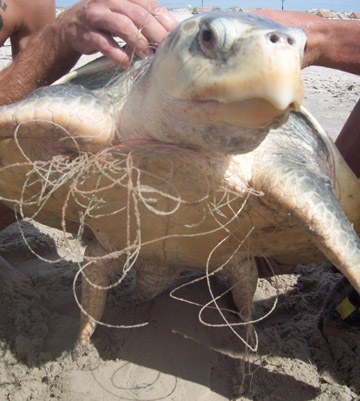When a sea turtle hatches, it skedaddles — it gets off the beach and into the water as fast as its little flippers will carry it. After that, it’s a life at sea. Females return to shore only to lay their eggs, while males may never return at all — unless something goes wrong.
 A Kemp's Ridley sea turtle stranded and entangled in fishing line at Padre Island National Seashore. Credit: National Park Service.
A Kemp's Ridley sea turtle stranded and entangled in fishing line at Padre Island National Seashore. Credit: National Park Service.Every year, something does go wrong for thousands of turtles along the Atlantic and Gulf coastlines of the United States — they wash up on the shore or float quite close to it, unable to return to sea.
Many of them will die, if they’re not dead already. But many are rescued and returned to the sea through the efforts of volunteers. Their work is coordinated by the Sea Turtle Stranding and Salvage Network. It was established by the federal government in 1980, and it works with state and local agencies in 18 states and the Caribbean.
Six species of sea turtles patrol these regions, all of which are listed as either threatened or endangered. They range from the highly endangered Kemp’s Ridley, which weighs in at less than a hundred pounds, to the leatherback, which can top the scales at a ton.
There are many reasons that a sea turtle can become stranded — from disease and old age to being hit by a boat or getting tangled in floating plastic. Hundreds become stranded when they suffer “cold stunning” — the weather suddenly turns cold, leaving the turtles disoriented.
The stranding network rescues hundreds of turtles every year, nursing many of them back to health and returning them to the sea — just where the turtles want to be.
For more information on NOAA’s Sea Turtle Stranding and Salvage Network and how to report stranded sea turtles, visit www.sefsc.noaa.gov/species/turtles/strandings.htm.

